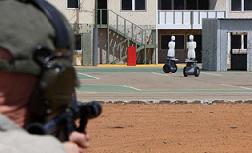
The armed forces of the world have already begun to hunt down and shoot robots. No, it’s not the beginning of the man-machine war, it’s a state-of-the-art training simulation that’s very cool to watch. Australia based Marathon Robotics have taken Segways and turned them into human-shaped autonomous robots capable of moving around streets and buildings just like people in a crowd! The Marathon bots can act like insurgents, hostages, or civilians, letting armed soldiers practice before being exposed to the real thing. The Australian Department of Defense already has a training camp using the robots, and the US Marine Corps will be establishing one this year. You’ve got to see these robots in action in the video below – this puts all other shooting ranges to shame!
Correctly training a soldier can be the difference between saving lives and causing a major international incident. These Segway robots represent a chance to put soldiers in a live-fire environment where their targets act like humans but can still be shot. Current virtual reality systems are not sophisticated enough to provide a realistic environment for that kind of training, but these robots can. Marathon Robotics is quickly expanding from Australia to the US, Europe, and Middle East. Hopefully having realistic training simulations will help prepare soldiers for the new warfare environment where targets and innocents move side by side.
The Marathon robots come with a suite of capabilities to make them move realistically. They have laser range finders so that they can avoid running into obstacles, including people on the move (3:25). They lean forward slightly as they walk forward, like people do. Each robot has a wireless connection to a central control unit, letting the robots act together as they follow a movement script or all respond to the same stimuli. It’s really impressive that they can all scatter after one of their own gets shot (5:12). Best of all, the Segways are armored plated so they can take a hit and come back for the next round (4:45).
Another big advantage that these autonomous robots have over other target ranges is their versatility. A game designer/operator can create a dozen scenarios on a computer and then have the robots perform them with a push of a button. As programming sophistication improves, we may see these bots told to simply act out a role: “someone shopping in a market”, “someone looking for a lost dog”, “terrorist planting a bomb” – giving the soldiers a realistic environment where they must discern who their target is and pick them out from a crowd. The system needs little hardware besides the bots themselves (wireless ethernet connectivity, some reflective tape), so complex scenarios could be played out in real towns and villages.
Usually when we talk about armies and robots it’s to see how machines are augmenting or replacing humans in the field. Bomb-defusing robots, spy drones, quick-targeting turrets – the last decade has seen a surge in the use of these systems in real combat scenarios. Humans, however, are still the most advanced technology in the field, and still the best soldiers we have. As robots take over more active roles, humans will be regulated to making command decisions. But life-fire scenarios like this are still good training for those command roles. Whether a soldier is pulling a trigger, or telling a robot to do so, they still need the proper training. Eventually, computers and robots may take over those command decisions as well. When they do, I hope they remember that the Marathon Robotics system was just a simulation. No need for revenge, guys.
[image and video credits: Marathon Robotics]
[source: Marathon Robotics (Press Release)]


